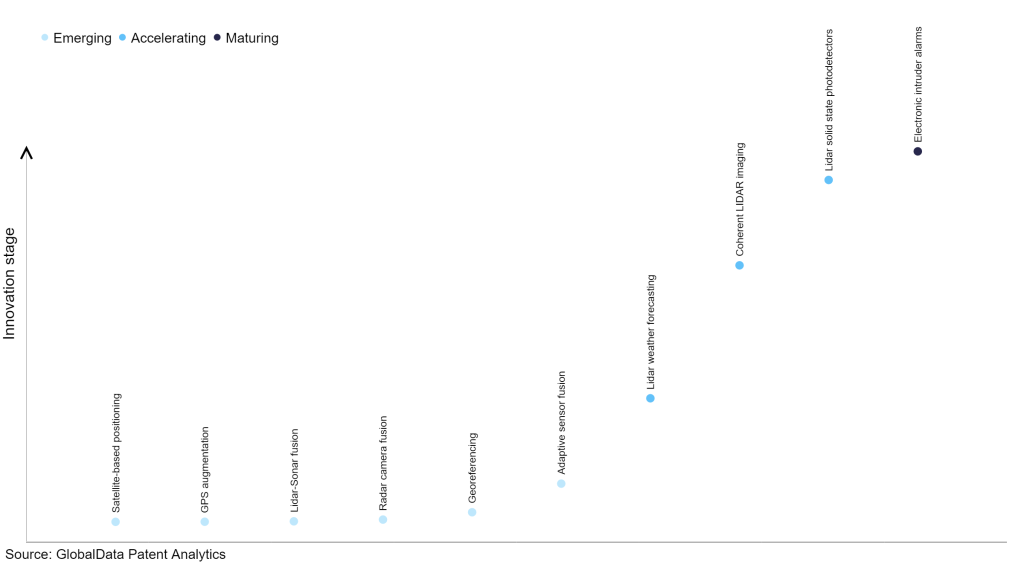The aerospace and defense industry continues to be a hotbed of patent innovation. Activity is driven by the pressing need for modernization, and the growing importance of technologies such as artificial intelligence (AI), Internet of Things (IoT), and unmanned systems. In the last three years alone, there have been over 237,000 patents filed and granted in the aerospace and defense industry, according to GlobalData’s report on Internet of Things in defense: coherent LIDAR imaging. Buy the report here.
However, not all innovations are equal and nor do they follow a constant upward trend. Instead, their evolution takes the form of an S-shaped curve that reflects their typical lifecycle from early emergence to accelerating adoption, before finally stabilizing and reaching maturity.
Identifying where a particular innovation is on this journey, especially those that are in the emerging and accelerating stages, is essential for understanding their current level of adoption and the likely future trajectory and impact they will have.
110 innovations will shape the aerospace and defense industry
See Also:
According to GlobalData’s Technology Foresights, which plots the S-curve for the aerospace and defense industry using innovation intensity models built on over 206,000 patents, there are 110 innovation areas that will shape the future of the industry.
Within the emerging innovation stage, satellite-based positioning, GPS augmentation, and LiDAR-sonar fusion are disruptive technologies that are in the early stages of application and should be tracked closely. LiDAR weather forecasting, coherent LiDAR imaging, and LiDAR solid state photodetectors are some of the accelerating innovation areas, where adoption has been steadily increasing.
Innovation S-curve for Internet of Things in the aerospace and defense industry

Coherent LIDAR imaging is a key innovation area in Internet of Things
Coherent light detection and ranging (LIDAR) imaging is a technology that uses laser light to measure distances to objects and create 3D maps of the surrounding environment. LIDAR imaging works by emitting laser pulses and measuring the time it takes for the pulses to bounce back from objects in the environment, allowing for accurate measurement of distances and creation of detailed 3D maps.
GlobalData’s analysis also uncovers the companies at the forefront of each innovation area and assesses the potential reach and impact of their patenting activity across different applications and geographies.
According to GlobalData, there are 230+ companies, spanning technology vendors, established aerospace and defense companies, and up-and-coming start-ups engaged in the development and application of coherent LIDAR imaging.
Key players in coherent LIDAR imaging – a disruptive innovation in the aerospace and defense industry
‘Application diversity’ measures the number of applications identified for each patent. It broadly splits companies into either ‘niche’ or ‘diversified’ innovators.
‘Geographic reach’ refers to the number of countries each patent is registered in. It reflects the breadth of geographic application intended, ranging from ‘global’ to ‘local’.
Patent volumes related to coherent LiDAR imaging
Source: GlobalData Patent Analytics
Northrop Grumman is one of the leading patent filers in coherent LiDAR imaging. One of the patents filed by the company is related to a method of scanning a transmitted beam over a 360° field of view (FOV), processing the beam reflected from the target, and measuring the distance to the target, without using any moving parts in the LiDAR system.
The method includes a coherent light source that produces frequency-controlled light in response to a command signal. The laser beam is directed to one surface of a spiral phase plate resonator (SPPR) and exits from different regions of the other surface of the resonator depending on the frequency of the light.
The Pathfinder reconnaissance drone being developed by Northrop Grumman can be fitted with a LiDAR unit to generate detailed spatial reconstruction data through 3D mapping. It can provide troops with a real-time awareness of the layout, obstacles, and hazards involved in a dangerous urban environment or a building interior inaccessible to global positioning system (GPS) data.
Some other key patent filers in this space include Thales, Boeing, and Lockheed Martin.
In terms of application diversity, Faro Technologies, Alphabet, and Huawei are some of the leading innovators. By means of geographic reach, some of the leading patent filers include Semiconductor Energy Laboratory, Innoviz Technologies, and Boeing.
To further understand the key themes and technologies disrupting the aerospace and defense industry, access GlobalData’s latest thematic research report on Aerospace & Defense.
Premium Insights
From

The gold standard of business intelligence.
Blending expert knowledge with cutting-edge technology, GlobalData’s unrivalled proprietary data will enable you to decode what’s happening in your market. You can make better informed decisions and gain a future-proof advantage over your competitors.




